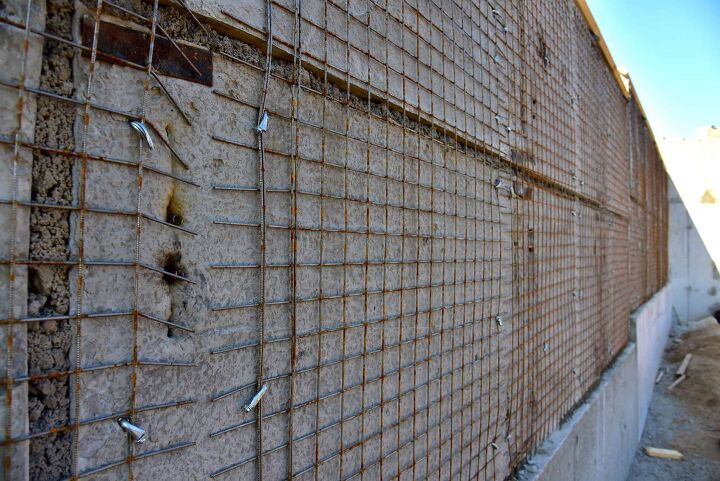What Are The Pros And Cons Of Fiber Mesh Concrete?

Concrete needs to be sturdy and last a long time. One way to help concrete be its best is to use fiber mesh concrete. Fiber mesh concrete involves adding fibers to a ready-made concrete solution. The fibers will help reinforce the solution. Different fibers such as glass, steel, and synthetic or natural fibers are mixed in to form the mesh.
When choosing whether or not fiber mesh concrete is for you, you need to understand the pros and cons. Fiber mesh holds the concrete together longer and gives the surface a higher impact resistance. However, it also is known to corrode steel fibers and cause injury.
This article will take you through the pros and cons so you can weigh the choice of fiber mesh against your project and whether this will be suitable for your needs. Let’s get started!
Do You Need Concrete Foundation Installers?
Get free, zero-commitment quotes from pro contractors near you.

Pros Of Fiber Mesh Concrete
Like everything, fiber mesh has pros and cons about using it. You have to make sure it’s suitable for your needs before you endeavor to use it for your project. Here are some of the advantages of choosing fiber mesh concrete.
Holds Concrete Together Longer
Cracking can occur because of changes in temperatures. It can also arise from density changes from setting the concrete. Fiber mesh does not keep cracks from forming. Instead, the fiber mesh will hold the concrete together and prevent it from falling apart.
When concrete is going through the curing process, the water inside the concrete evaporates. The method of water evaporation can cause cracks in the concrete. Fibers such as polypropylene reduce cracking by protecting the concrete from stresses. And steel fibers reduce cracking by intersecting cracks and stopping their growth.
Helps With Bleed Water
There are only a few ingredients that make cement. These ingredients include the following:
- Cement
- Water
- Aggregates such as:
RockSandGravel
Water is the lightest of all these ingredients. And not all of it gets absorbed by the sand and cement. For these reasons, this will cause excess water to rise to the surface. The water will then pool on the surface of the concrete. This is known as bleed water.
Fiber mesh concrete bleeds more evenly than plain concrete. As a result, you will not experience a puddling effect. Fiber mesh concrete will look more like a wet sheen.
Gives The Concrete Surface A Higher Impact Resistance
Fiber mesh concrete reduces the total crack void structure. This will give the concrete a greater shock-absorbing quality. The concrete will change from a brittle material to a more ductile material.
Takes Less Time Than Wire Mesh To Use
Wire mesh requires careful measuring in order to fit the side of the pour. It also must hold up to a certain level during the pouring process. Alternatively, fiber mesh can be added directly to the concrete mix. This removes the extra step of measuring before pouring.
It Is A Better Option For Certain Projects
Depending on your project, you can’t use reinforcements like rebar or wire mesh. Instead, only fiber mesh concrete will work. If you need to make a thin structure, like a kitchen countertop, rebar won’t work. Instead, you will need to use fiber mesh concrete. If you need to lay a thin layer of pavement, rebar won’t work. Again, you will need to use fiber mesh concrete.
Helps Prevent Fire Damage
Spalling is when the surface of the concrete is heated, forms steam, and then the surface explodes. When fiber mesh concrete is exposed to heat, the fibers inside the concrete will melt. This gives the water inside the concrete a chance to expand and move away from the heat, preventing spalling.
Freeze-Thaw Resistance Is Improved
Water expands when it is frozen. And water inside concrete is susceptible to freezing. Freezing creates pressure in the concrete’s pores. And if the pressure exceeds the tensile strength of the concrete, the concrete can rupture.
After exposure to several freeze-thaw cycles, things like cracking, scaling, and crumbling can occur. When fibers are added to concrete, its freeze-thaw resistance will improve. Polypropylene and nylon fibers are generally used to increase freeze-thaw resistance.
Fiber Mesh Is More Cost-Effective
To determine the cost-effectiveness of fiber mesh, there are several things to consider:
- Material cost–actual cost of the product
- Handling Cost–cost to handle the material. Includes off-loading, storing, and moving.
- Cost to Place–Amount it costs to put the material in place
- Permanent Support Costs
- Concrete Pump Costs
When you compare fiber mesh to wire mesh, it breaks down like this:
Calculations For All Are For The Size Of 6×6 W 1.4 x W1.4
| Wire Mesh | Fiber Mesh (Microsynthetic Fibers) | Fiber Mesh (Macrosynthetic Fibers) | |
| Cost of Material | $0.28/sq. ft. | $0.13 sq. ft. | $0.38 sq. ft. |
| Handling Cost | $0.03/sq. ft. | $0 | $0 |
| Cost to Place | $0.10/sq. ft. | $0 | $0 |
| Permanent Support Costs | $0.30/sq. ft. | $0 | $0 |
| Concrete Pump Costs | $0.075/sq. ft. | $0 | $0 |
| Total | $0.51 sq. ft. | $0.13 sq. ft. | $0.38 sq. ft. |
As you can see from the table above, micro synthetic fiber mesh is the most cost-effective. And while wire mesh costs less than macro synthetic fibers, ultimately, the fiber mesh is more cost-effective.
Cons Of Fiber Mesh Concrete
As fiber mesh concrete has advantages, it also has disadvantages. Sometimes, these cons can make or break the decision on using this product. Therefore, we felt it was vital for you to know the downside of using fiber mesh before you decided for sure if it’s the ideal product for your project.
Creates A Hairy Finish
When fiber mesh concrete is laid, some fibers will protrude from the surface. The protrusion of fibers will give the concrete a hairy look. If the appeal isn’t a worry to you, then this isn’t a big deal.
Potential Injury Caused By Glass Or Steel Fibers
Both glass and steel fibers are sharp. If glass or steel fibers are used in the concrete mixture, it may cause injury. Common injuries would include cuts, which could be severe.
Uneven Distribution Of Fibers Throughout The Concrete
When fibers are added to the concrete mixture, it is impossible to tell where in the mix the fibers will end up. Some portions of the concrete will end up having more fibers than other parts. This will cause the concrete to have different properties in higher fiber areas versus lower fiber areas.
Corrosion Of Steel Fibers
If steel fibers are used in the fiber mesh mix, the steel fibers will corrode over time. The corrosion will adversely impact the performance of the steel fibers and potentially affect the performance of the cement.
Does Fiber Mesh Replace Rebar?
Fiber Mesh Concrete is not intended as a substitute for rebar. The two can be used jointly for extra reinforcement, but never use fiber mesh as a substitute. The mesh isn’t strong enough to withstand the weight and force that rebar can.
What Is The Difference Between Microfibers And Macro fibers?
Microfibers are generally used to minimize early age cracking. Microfibers are generally classified by their length. Sometimes the diameter or the aspect ratio is considered. Microfibers are known as structural fibers. They are equal to or greater than 1.5 inches. These fibers are intended to carry the load.
Macrofibers are used in non-structural applications to replace traditional reinforcement. These fibers are also used to minimize or eliminate early and late age cracking. When using fibers instead of wire mesh or rebar, then macro fibers must be used.
Related Questions
What are other types of reinforcement used in concrete?
Other types of reinforcements used are wire mesh and rebar. When choosing which type of reinforcement to use, you will first need to weigh the pros and cons of each product.
What is wire mesh?
Wire Mesh is a series of wires welded together to form a grid. When using it in concrete, the wire mesh is placed down before the concrete is poured.
While the concrete is being poured, the wire mesh will be raised, so it runs along the middle of the concrete height. The concrete that sets around the wire mesh will ultimately have a reinforcing material inside.
What is rebar?
Rebar, also known as reinforcing steel or reinforcement steel, is a steel bar. Rebar is used in structures as a tension device to strengthen and help concrete while it is under tension.
What types of fibers are used in fiber mesh concrete?
Fibers types include the following:
- Polypropylene
- Polyethylene
- Acrylic
- Acrylic
- Steel
- Cellulose
- Grass
- Glass
- Carbon
Do You Need Concrete Foundation Installers?
Get free, zero-commitment quotes from pro contractors near you.

Wrapping It Up
One misunderstanding for most people when it comes to fiber mesh concrete is that it’s just like rebar. That couldn’t be further from the truth. Rebar reinforces the area you set it in by absorbing the stretching forces so that the concrete can remain strong and secure. While fiber mesh is mixed in with the concrete to reinforce the concrete’s entirety.
So, as you can see, there are ideal projects in which you would use fiber mesh versus rebar and vice versa. What you choose depends highly upon your needs. By comparing the pros and cons of fiber mesh, you can then compare it to your particular needs to decide if this is indeed the best reinforcement type for you.
Related Guides

We are a team of passionate homeowners, home improvement pros, and DIY enthusiasts who enjoy sharing home improvement, housekeeping, decorating, and more with other homeowners! Whether you're looking for a step-by-step guide on fixing an appliance or the cost of installing a fence, we've here to help.
More by Upgraded Home Team












![10 Best Electric Lawn Mowers - [2022 Reviews & Top Rated Models]](https://cdn-fastly.upgradedhome.com/media/2023/07/31/9070486/10-best-electric-lawn-mowers-2022-reviews-top-rated-models.jpg?size=350x220)














